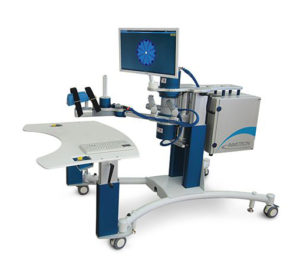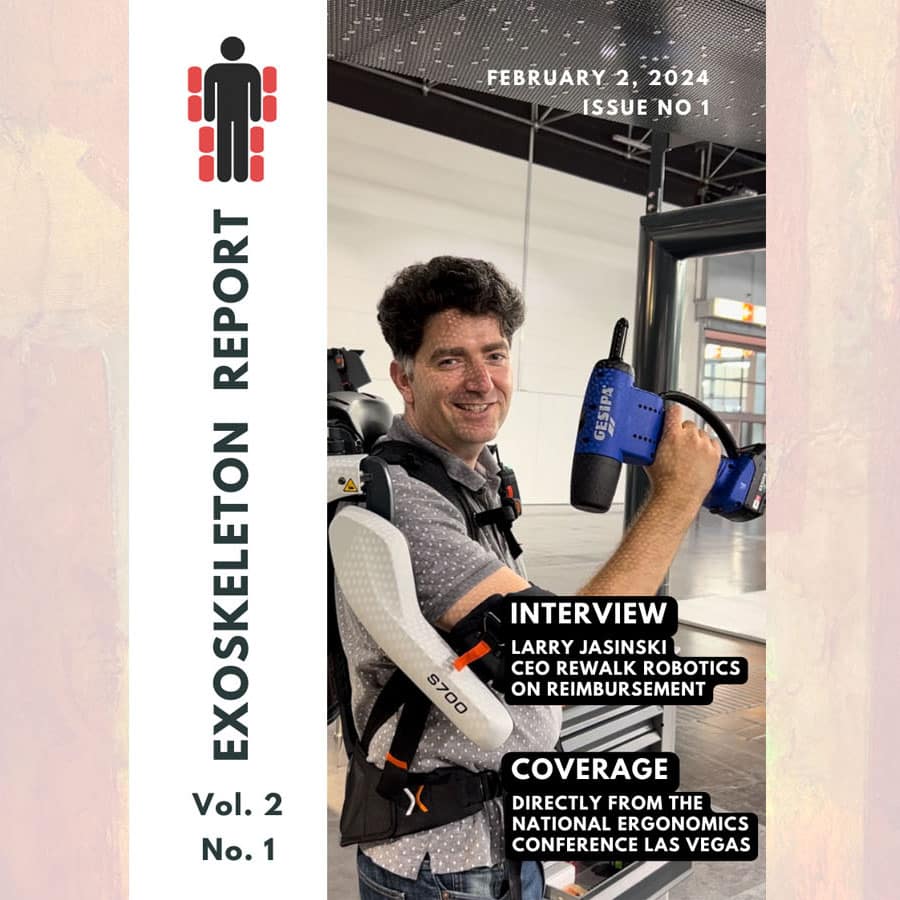This June, Ekso Bionics hosted Dr. Dylan Edwards who led an objective presentation and discussion on his experience with the Ekso GT for gait rehabilitation and the obstacles to its wider adoption. Dr. Dylan Edwards is the Director of the Non-Invasive Brain Stimulation and Human Motor Control Laboratory at Burke Rehabilitation & Research Institute. There have already been testimonials of professionals using rehabilitation exoskeletons but the presentation by Dr. Edwards is completely unique for several reasons:
- Dr. Edwards already has experience with robotics rehabilitation. He was an early adopter of the InMotion Wrist by Interactive Motion Technologies (IMT, now purchased by Bionik Labs). Dr Dylan and his team of rehabilitation professionals have already gone through the experience of learning how to integrate a robotic device in their rehabilitation program. This includes writing procedures, getting a feeling for who can benefit most from the device, the number of professionals needed at all times and countless other parameters.
- Dr. Edwards is a manager. As such he not only has to determine how to use to Ekso GT but has a much better bird’s-eye view of the entire process: how efficient is the device, is the cost justifiable, what are the benefits and how to optimize them, how well are the rehabilitation professionals utilizing the Ekso GT, etc… This presentation has a very unique point of view.
- The impact of the work done by the Burke Rehabilitation & Research Institute on its patients has already been well covered by the media. Inspirational: Stroke Survivor Who Learned to Walk Again is the story of Brad Berman, who at age 37 was in great physical condition but suffered a stoke. He underwent intense physical therapy at the Burke Institue using the Ekso GT and other rehabilitation equipment. This is the first time that we can present the same story from the point of view of the patient and the team leading the rehabilitation program.
- Finally, Dr. Edwards is very objective in his outlook for rehabilitation robotics. He is looking to quantify the usefulness of medical robots without using any subjective data and opinions.
Now that we have seen the unique position that Dr. Edwards is in to talk about the Ekso GT and its adoption limitations, here is what he had to say:

The Burke Rehabilitation & Research Institute sees over 400 stroke patients per year. Dr. Edwards and his rehabilitation team had years of experience working with the IMT InMotion Wrist and were well versed in upper extremities rehabilitation. It became obvious however, that the institute was missing gait training. In 2004 with the help of fundraising by the Berman family the center was able to acquire one unit of the Ekso GT and establish a gait rehabilitation program. Using their experience with upper body robotic devices, the center drafted an initial protocol for the use of the Ekso GT. For example, the InMotion Wrist was shown to be most effective if used for 36 sessions and that number was initially applied to the Ekso GT. Originally a patient would use the exoskeleton three times a week for 12 weeks for a total of 36 sessions. This is a unique situation because in most centers companies like Ekso Bionics have to introduce not only their product but the idea of robotics rehabilitation to the medical staff. In this case, it was IMT that had done the pioneering of rehabilitation robotics and the Ekso GT became another purchase for the Burke Institute. The main challenge did not come from integrating the Ekso GT into the rehabilitation program, but objectively measuring the outcome of its use: who is responding to it and in what way.

Dr. Edwards highlighted that the Ekso GT is not an augmentation device but a rehabilitation one. The patient should use it to accelerate their gait training, but should reach a point where they have improved so much that they no longer need it (for more on augmentation vs rehabilitation exoskeletons refer to: 42 Medical Exoskeletons into 6 Categories).
The presentation listed many advantages of the Ekso GT. It is compact and doesn’t take up a lot of space (multiple units can just be hanged along a wall). It allows for patients to move out of the rehabilitation area. It reduces the strain on the rehabilitation specialists. The device has several modes and power assist ratings that can be changed on the fly, creating a link between the rehabilitation device and the rehabilitation professional. The Ekso Bionics team was recognized for being very helpful with questions (again this is coming from a manager that has worked with many medical robotics companies). A new prototype data acquisition system was tested on the unit shipped to the Burke Institue which was most successful (the Ekso Bionics team added that the system will be rolled out to all Ekso GT suits in the near future).
Hospital Adoption Challenges for the Ekso GT
From the presentation by Dr. Dylan Edwards it finally becomes clear what is the delay with adopting rehabilitation exoskeletons such as the Ekso GT in hospitals and rehabilitation gyms around the world:
- Lack of numerical data showing impact of robotic gait rehabilitation
- Lack of protocols leading to inefficient use of the exoskeletons
- Still building a case for purchasing exoskeletons from a financial point of view

The gait rehabilitation program at Burke used multiple methods to quantify the effectiveness of the Ekso GT on 14 patients. Analyzing data from pressure plates, timed walking tests without assistance before and after using the Ekso GT, and pulling data directly from the device were only half of the methods used. All of the results were positive on average, but not consistent from patient to patient.
This can be explained by the lack of finalized protocols. When the Burke Institute received their exoskeleton in 2014 they used their experience with upper body rehabilitation to draft best use practices. Since then, through trial and error all of the major parameters such as sessions per week, session duration and assistive level have been changed. However, these changes have made data analysis much harder. Another challenge is understanding why some patients don’t seem to benefit from the use of the exoskeleton in a way that can be currently measured. One example given was a rehabilitation professional would visually observe improved gait, but that wasn’t being captured by improved walking speed.
In order to make sense of this Dr. Edwards divides the benefits of using the Ekso GT into primary and secondary. Primary effects are reduction of rehabilitation staff, one professional using an exoskeleton on a patient vs two or more professionals trying to provide rehabilitation over a treadmill. Other primary benefits include improvement in the consistency and involvement of the rehabilitation program (Dr. Karen Nolan’s presentation, Clinical Trials With The Ekso GT, covered the last two in great detail). Secondary effects include improved mental state, bowel movement, circulation and decrease of bedsores.

Dr. Edwards emphasized that current studies still include all kinds of patients, from ones that don’t have enough muscle strength and control to use the Ekso GT to those that are too far along their rehabilitation to benefit from the wearable robot. As researchers gain more knowledge and understanding on the proper target group for exoskeleton rehabilitation, experimental results are going to become much more clear and definitive.
With all of the ambiguity into the proper and efficient use of medical exoskeletons it is no wonder that they haven’t been widely adopted in hospitals and rehabilitation centers! This finally clarifies where the holdup is occurring. At this point, research centers are still investigating how many people are needed to operate an exoskeleton, how many times per day the machines can be used, for how long in a session and for which patients. As this data is being collected, the cost to benefit ratio can be determined and generating a business case for the adoption of exoskeleton rehabilitation will become much easier.
The Red Flag Act

From this and many other presentations over the past year it appears that medical exoskeletons are where cars were in 1865 with the passage of the Locomotive Act, more commonly known as the “Red Flag Act” (wiki). While the act implemented many important laws such as vehicle registration and speed limits it also restricted travel speed to 4 mph in the country and 2 mph in the cities. Furthermore, the law required a person to carry a red flag in front of vehicles. It wasn’t until 1896 that most of the restrictions were lifted or loosened and cars started appearing in larger quantities. It was the initial confusion that caused a slowdown in the adoption of automobiles. In this respect, the exoskeleton industry is much closer to 1896 than 1865, with a lot of the ambiguities being hammered out. In other words, it will not be surprising to see a massive increase in sales of the Ekso GT and other rehabilitation robotics within a year.
For more visit:
Restorative Neurological Clinic, Burke Research Institute: http://www.burke.org/research/research-focus/restorativeclinic
Train The Brain: http://www.run4brad.com
Ekso Bionics: http://eksobionics.com



Add Comment